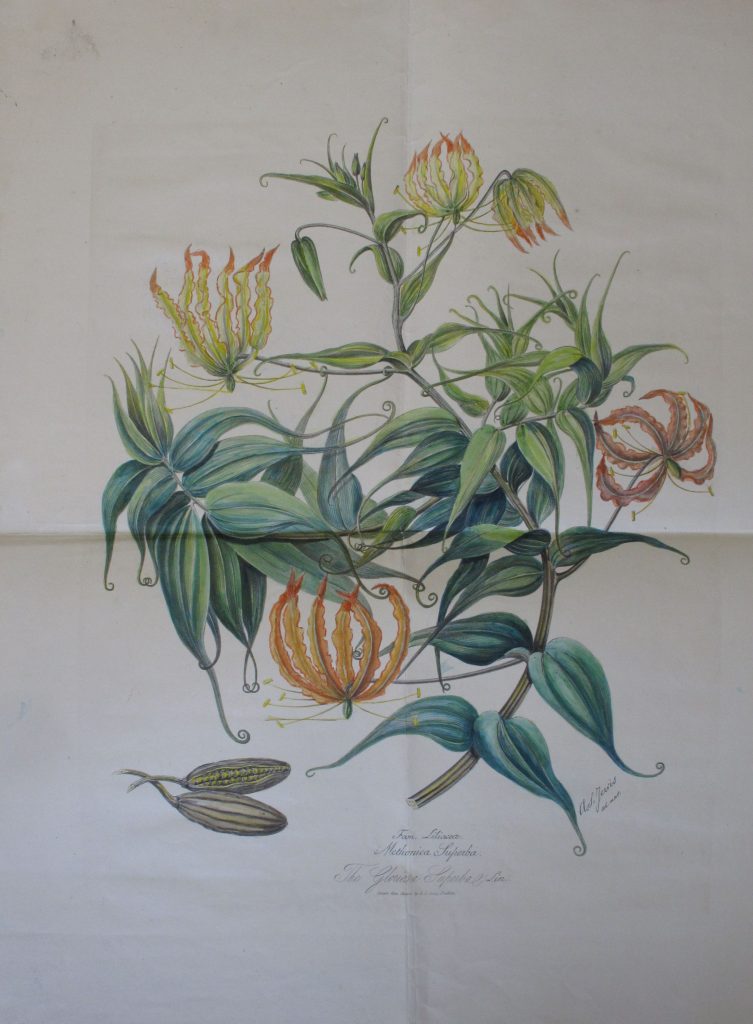In the past I have written about botanical ‘swagger prints’ – large-format illustrations commissioned at least in part to boost the ego of the commissioner. At RBGE (from Cleghorn’s library), is a spectacular elephant-folio volume of this type, a set of chromolithographs of eight Cape of Good Hope species, published in London in 1849 as Specimens of the Flora of South Africa, by a Lady. The lady in question was Arabella Roupell, wife of George Boone Roupell, a Madras civil-servant colleague of Cleghorn, and as I have recently discovered grandson of George Roupell of Charleston, South Carolina, who in the late 1760s drew a watercolour of Spigelia marilandica in the Hope collection. In the RBGE library are two similar volumes of lithographs of Indian plants, one by Margaret Read Brown (née Inverarity) who was a friend both of Cleghorn and of Mrs Roupell, her Wild Flowers of Southern & Western India (1866). The other is by Marianne Cookson (née Stephenson): Flowers Drawn and Painted after Nature in India (c 1835), a rare publication that was presented to RBGE by Queen Elizabeth II when she opened the library and herbarium building in 1964.
It was therefore interesting to discover another example of the genre, by a previously unknown botanical artist. This one was lurking among the rare prints that I extracted from the Illustrations Collection many years ago and which continue to throw up surprises. The print appears to be a one-off, though, at 624 x 491 mm, is in a similarly large format to the works of Mesdames Browne, Roupell and Cookson. Its size has unfortunately led to its being folded in four for mounting on a horrible backing sheet for incorporation into the collection – in this case into the family Liliaceae, as it depicts the climbing glory lily Gloriosa superba (now placed in Colchicaceae). In style it is similar to the work of Mrs Brown; it is signed on the plate by ‘A.S. Jervis’, and annotated on the recto as having been presented to RBGE on 9 March 1904. Thanks to Google another copy of the print has been located, presented to the Massachusetts Horticultural Society in the same year as ours; fortunately the Society has kept better records than RBGE, which has allowed a reconstruction of the plate’s history. The American copy bears Mrs Jervis’s full name and a note that it was presented by her daughter. The donor was thus Annie Eliza Scott Guerritore, who lived in Naples, where her mother had died (at Posillipo) in 1886. Doubtless, nearly twenty years later, Signora Guerritore had a clear-out and sent copies of her mother’s beautiful print to botanical libraries in several parts of the world.
In 1831, at Mahabeleshwar, a Bombay hill-station in the Western Ghats (where Mrs Brown painted many of her plants), Anne Sarah Paget (1801–1886) had married Thomas Best Jervis. Thomas and his brother, George Ritso Jervis, were distinguished engineers who both worked for the Bombay government. Both had far wider interests (Thomas was a FRS), among which was lithography, and as early as 1829 George had set up a lithographic press at Poona, which he used for reproducing maps, but also texts in Indian script, to allow the development of one of his major interests that of ‘Native education’. After retiring back to London, to No. 9 Regent’s Villas in genteel Regent’s Park, his younger brother Thomas set up his own lithographic press, and it was on this that he doubtless printed his wife’s drawing of Gloriosa at some point before his death in 1857. In 1844 he wrote to the Asiatic Society of Bengal in Calcutta offering to produce the illustrations for their journals, and as a specimen sent a lithograph of Argemone mexicana which he (though more than probably his wife) had copied from a plate by Robert Wight. The offer was not taken up, largely on the grounds of geographical impracticability, but interestingly the correspondence in the Society’s journal elicited what was probably the last publication of the great botanist William Griffith. The Society had consulted him for an informed opinion on the lithography of botanical illustrations, and his reply was posted back to Calcutta from Kedgeree as he steamed out of the Hooghly on the way to an early grave in Malacca, two months later.
Those who are following this series of ‘Botanic Stories’ will not be surprised to learn that a further Cleghornian angle can be added to this story. Before finding the presentation date on the back of the print it seemed likely, from its Indian links, that it might once have been part of the Cleghorn Collection, but the date of 1904 precluded this. However, I then discovered that the artist’s husband was born at Jafna, Ceylon, in August 1796, which, both on account of place and date, set up a clamour of bells. In January 1796 Cleghorn’s grandfather was in Ceylon, to persuade the de Meuron regiment to switch its allegiance from the Dutch to the British. With him that month Cleghorn had with him the Tranquebar missionary J.P. Rottler (to collect plants, which were sent to Banks, and as Tamil translator) and he also had a meeting in Jafna with John Jervis ‘Senior Asssistant to the Resident [of Jafna] and Superintendent of the Revenue of the Island of Ceylon’. If Cleghorn met Mrs Jervis on this occasion, he might have noticed a bump indicating the early stages of pregnancy: seven months the bump would emerge as Thomas Best Jervis!

